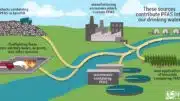By Will Atwater
At a sparsely attended meeting in May at the Carrboro-based Orange Water and Sewer Authority board member Todd BenDor asked Stephen Winters, OWASA’s executive deputy director, an expensive question about what it would cost the utility to clean up the PFAS present in its water, which supplies about 80,000 customers in southern Orange County.
“Back in December [2023], the estimate [for] PFAS infrastructure was $63 million,” he said, referring to the cost for new construction to process the per- and polyfluoroalkyl substances showing up in the water. “And then, I think, in February, it was $75 million. What happened?”
Winters told the board — and the dozen or so local residents present — that the initial estimate only reflected costs for construction of PFAS remediation equipment.
The higher number represents the potential total cost for PFAS remediation — almost a thousand dollars a resident — which includes design, pilot testing and installation of a granular activated carbon system that will filter out the persistent chemicals, which have been found to have multiple effects on human health.
The room fell silent.
Documents distributed at the meeting described how during the next five years, OWASA anticipates spending even more than that $75 million to upgrade its PFAS removal system at a new facility.
Seven years ago this month, per- and polyfluoroalkyl substances, or PFAS, were discovered in the Cape Fear River, an event which has shaken residents in the Southeastern region of North Carolina and raised awareness of water quality issues like never before
Conversations about PFAS remediation costs are happening for many public water systems across the state. In April, the Environmental Protection Agency finalized the National Primary Drinking Water Regulation. The regulation sets maximum contaminant levels for six PFAS, including PFOA, PFOS and GenX, which were manufactured at the Chemours Fayetteville Works plant and used at countless industrial sites throughout North Carolina and the country.
On Tuesday, members of the North Carolina House Environmental Committee voted in favor of House Bill 864, which would hold manufacturers of PFAS responsible for the cost incurred by state water systems upgrading their water treatment technology to treat the contaminants. The bill received a favorable report and will move out of committee. It must pass the House and Senate before becoming law.
Public water systems have three years (until 2027) to evaluate the levels of PFAS in their water supply and share results with the public. If PFAS are found at levels that exceed the standards, systems have five years (until 2029) “to implement solutions to reduce PFAS in their drinking water,” according to the regulation.
Earlier this month, Gov. Roy Cooper declared June 3-7 PFAS Awareness Week.
“North Carolinians deserve clean water, and we must be at the forefront of the fight to contain forever chemicals,” Cooper said in a statement.
But standing at the forefront in the battle against PFAS will be an expensive endeavor for many local communities.
Understanding PFAS
Also known as “forever chemicals” due to their potential to persist in the environment for thousands of years, PFAS comprises nearly 15,000 compounds, according to CompTox, a chemical database maintained by the Environmental Protection Agency.
For nearly 70 years, PFAS has been a mainstay in the consumer market, and variations are found in a wide range of manufactured goods, including — but not limited to — nonstick cookware, cosmetics, water-resistant rain gear, runproof mascara, upholstery, electronics, food packaging, and some firefighting foams.
Now, PFAS are present in the blood of 95 percent of the U.S. population, according to a study led by researchers from Duke University. The chemicals are associated with such adverse health effects as increased cholesterol levels, kidney and testicular cancer, dangerously high blood pressure in pregnant women and decreased vaccine response in children, among other conditions.
Furthermore, a study led by a researcher from UNC Chapel Hill published in December 2023 found that children with prenatal exposure to two types of PFAS compounds — perfluorooctanoate (PFOA) and perfluorononanoate (PFNA) — were more likely to experience childhood obesity.
The research is ongoing.
A growing demand for PFAS remediation
The new PFAS treatment facility, OWASA states, is part of the capital improvements it expects to complete during a five-year-period that will result in an estimated 15 percent rate increase to the system’s 23,000 accounts. If implemented, “the typical household’s (3,000 gallons of water and sewer service)” bill would increase by $12.32 per month,” starting in Oct. 1, 2024, with half the amount tied directly to the PFAS treatment enhancement project, said Katie Hall, the system’s spokeswoman.
OWASA is not alone.
Wilmington-based Cape Fear Public Utility Authority has nearly 74,000 individual accounts and serves 200,000 customers, according to Cammie Bellamy, the organization’s spokeswoman.
In 2019, CFPUA began constructing a granular activated carbon filtration system at its Sweeney Water Treatment Plant, and it came online in 2022. CFPUA spent $54 million on the upgrade and anticipated that operational expenses would be nearly $4 million in the first year, increasing to “at least five million in subsequent years,” according to the company’s website.

Chatham County Utilities and Water provides water to more than 11,000 customers and will need to install a granular activated carbon filtration system at its Beaver Creek Water Treatment Plant, according to an email from Blake Mills, public utilities director. Mills added that the water treatment enhancement project will cost between $6.5 million and $8 million. Regarding a rate increase, Mills wrote, “It is possible that the GAC system could lead to a water rate increase in the future.”
There are more than 300 water systems in North Carolina that have PFAS levels that will exceed the standards, according to the North Carolina Department of Environmental Quality.
That number includes “42 municipal water systems serving nearly 3 million residents combined, as well as approximately 20 percent of small public water systems tested.”
All those customers are likely to take a financial hit.
Financial assistance
The EPA is funneling close to $1 billion to help states and territories fund PFAS testing and treatment at public water systems and to assist private well owners with mitigating PFAS contamination. The funding is part of the Bipartisan Infrastructure Law that passed in 2021 and is tied to a $9 billion commitment to eradicate PFAS and other emerging contaminants from drinking water. An additional $12 billion available if needed, according to an April news release from the EPA.
To ensure that small water systems don’t get overlooked, the administration announced in May more than $30 million to help small systems build their technical, managerial and financial capacity and comply with the National Drinking Water Standard.
The EPA defines small systems as those that serve 10,000 or fewer customers. There are nearly 2,300 water systems in North Carolina that fit this definition, according to DEQ.
Another portion of the federal funding is allocated to assist private well owners with PFAS testing.
The National Rural Water Association will receive nearly $8 million to work with small water utilities on areas that include “maintaining compliance with the Clean Water Act” by testing systems for PFAS, according to the EPA.
If things go as expected, “we’ll start with [PFAS] baseline testing,” said Heather Somers, executive director, North Carolina Rural Water Association. “There are still a lot of systems in North Carolina that have not done that yet because they haven’t been required to … It costs a lot for the small systems to do [testing], which is why the EPA provided funding.”
Josh Ward, interim town manager for the Town of Tabor City, whose system supplies water for roughly 1,200 customers, echoes the need for federal support.
“Small systems don’t have the benefit of economies of scale, particularly in the fact that each resident ends up bearing a significantly greater portion of the cost of operating a system than what would be felt by a resident of a larger system.”
‘Shifting the burden’
In the release from the governor’s office announcing PFAS Awareness Week, Cooper said, “We are holding polluters accountable, researching solutions, and working hard to protect people’s health.”
The need to hold polluters accountable is something that animates advocates who are fighting to get companies such as Chemours, which admitted that it discharged PFAS into the Cape Fear River, to pay up and stop releasing the compounds into the environment.
Numerous filings are moving through the legal system, including lawsuits filed by state attorneys general, attorneys representing individuals, and multidistrict settlements, that are expected to lead to financial compensation for water systems and individuals affected by PFAS. But when — and if — that will occur, and whether the money will be enough to compensate communities, remains to be seen.
Before the OWASA Board closed the PFAS discussion, which included the idea of starting a letter-writing campaign directed at the North Carolina General Assembly to ask for state funds to offset the cost of complying with the National Primary Drinking Water Regulation, board member Kim Piracci expressed her frustration.
“I think it’s fine to ask for money from the state or the federal government,” Piracci said. “But then we’re shifting the burden from the ratepayer to the taxpayer.” She added, “We need to pound the source of these things and get the polluters to pay…The rates are going to be horrendous, it’s true, but it’s just one of the bad things in life.”
Approval of the fiscal year 2025 budget is expected at OWASA’s June board meeting.
NC Health News editor Rose Hoban contributed reporting to this story.












